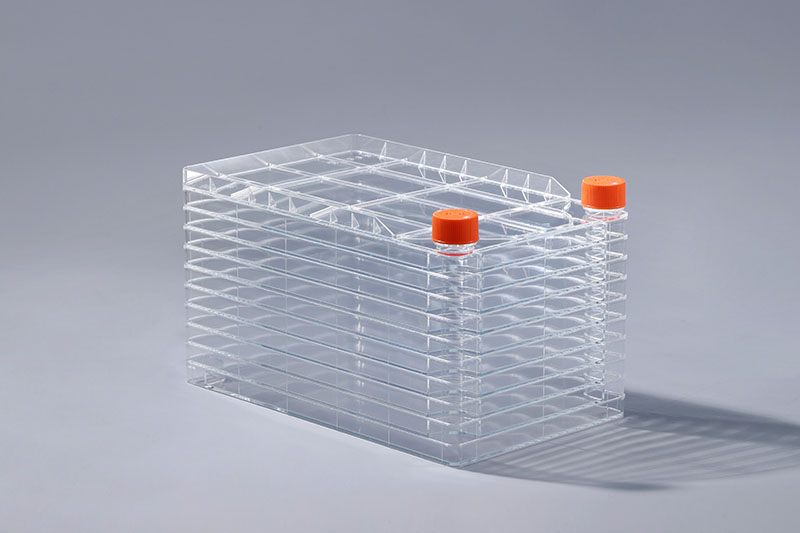Is cultúr cille ilshraitheach inchaite é Go ginearálta, is iad na monarchana cille a úsáidtear i dtáirgeadh ar scála mór vacsaíní polio ná 10 nó 40 sraithe den chuid is mó. Mar gheall ar a mhodh oibríochta áisiúil agus sábháilte, tá níos mó agus níos mó úsáideoirí táirgeachta baile agus taighde eolaíochta ag baint leis, agus tá raon feidhme an iarratais ag leathnú de réir a chéile. a bhfuil ról tábhachtach aige in ullmhú táirgí bitheolaíocha agus teiripe cille. Ina measc, úsáidtear an inchaite seo chun vacsaín polaimiailítis a tháirgeadh. Is galar tógálach géarmhíochaine é an polaimiailíteas de bharr an phailivíris. Is iad na léirithe cliniciúla go príomha fiabhras, comharthaí an chonair riospráide uachtarach, agus pian géag. Ionraíonn an víreas go príomha ábhar liath agus bán adharc roimhe chorda an dromlaigh daonna, rud a fhágann damáiste buan don ábhar liath, rud a fhágann pairilis flaccid ar na géaga. D'fhéadfadh roinnt othar pairilis nerve moillithe a fhorbairt agus sequelae pairilis a fhágáil, atá níos coitianta i gcoitinne i leanaí faoi bhun 5 bliana d'aois, mar sin tugtar "polio" air. Is bealach eacnamaíoch agus éifeachtach é an vacsaíniú chun scaipeadh na polaimiailítis a chosc agus a rialú. Is féidir an galar a chosc agus teasfhulangach, agus nuair a bhíonn pairilis géaga ann, is furasta é a bheith míchumasaithe ar feadh an tsaoil nó fiú bagrach don bheatha. I measc na sonraíochtaí coitianta tá 1 ciseal, 2 shraith, 5 sraithe, 10 sraith, agus 40 sraith. Is féidir úsáid a bhaint as an inchaite seo chun vacsaín polio a ullmhú costais táirgthe agus spás táirgthe a laghdú, agus tá an próiseas cobhsaí. , tá an caighdeán inrialaithe. I gcomparáid le gnáthchultúr fleascán spinner, is féidir níos mó táirgeacht cille a fháil.
Polio vaccine, or polio vaccine, is an effective means of preventing and eradicating polio. Polio is an acute infectious disease caused by the poliovirus. The clinical manifestations are mainly fever, upper respiratory tract symptoms, and limb pain. The virus mainly invades the gray and white matter of the anterior horn of the human spinal cord, causing permanent damage to the gray matter, resulting in flaccid paralysis of the limbs. Some patients may develop delayed nerve palsy and leave paralysis sequelae, which are generally more common in children under the age of 5, so it is commonly known as "polio". Vaccination is an economical and effective way to prevent and control the spread of polio. The disease is preventable and refractory, and once it causes limb paralysis, it can easily become life-long disability or even life-threatening.
The cell factory is a new type of cell culture consumables. Common specifications include 1 layer, 2 layers, 5 layers, 10 layers, and 40 layers. Using this consumable to prepare polio vaccine can reduce production costs and production space, and the process is stable. , the quality is controllable. Compared with ordinary spinner flask culture, more cell yield can be obtained.
In general, the cell factories used in the large-scale production of polio vaccines are mostly 10 or 40 layers. Due to its convenient and safe operation method, it has been favored by more and more domestic production and scientific research users, and its application scope is gradually expanding.
The FAI climbed 5.9 percent year-on-year in the first 11 months of 2018, quickening from the 5.7-percent growth in Jan-Oct, the National Bureau of Statistics (NBS) said Friday in an online statement.
The key indicator of investment, dubbed a major growth driver, hit the bottom in August and has since started to rebound steadily.
In the face of emerging economic challenges home and abroad, China has stepped up efforts to stabilize investment, in particular rolling out measures to motivate private investors and channel funds into infrastructure.
Friday's data showed private investment, accounting for more than 60 percent of the total FAI, expanded by a brisk 8.7 percent.
NBS spokesperson Mao Shengyong said funds into weak economic links registered rapid increases as investment in environmental protection and agriculture jumped 42 percent and 12.5 percent respectively, much faster than the average.
In breakdown, investment in high-tech and equipment manufacturing remained vigorous with 16.1-percent and 11.6-percent increases respectively in the first 11 months. Infrastructure investment gained 3.7 percent, staying flat. Investment in property development rose 9.7 percent, also unchanged.
 English
English



















































